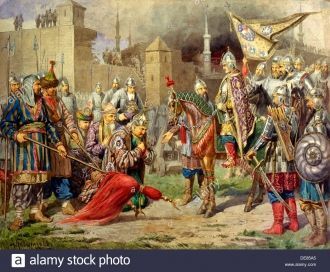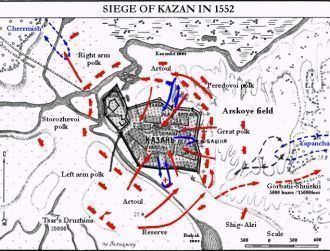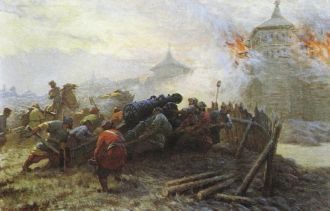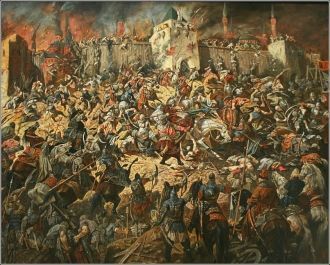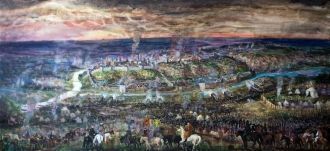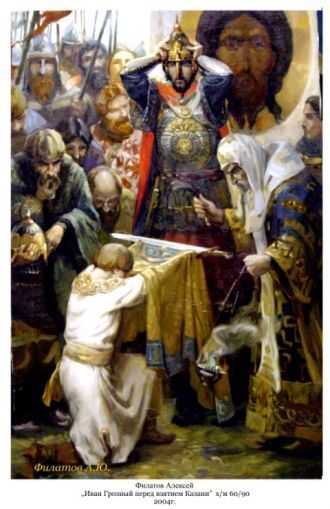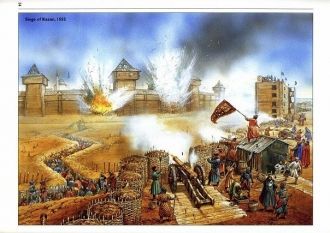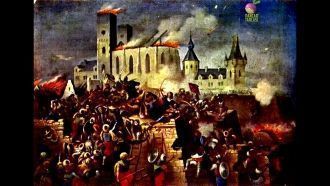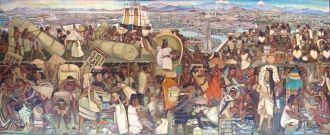Russia, Kazan
The Siege of Kazan in 1552 was the final battle of Russo-Kazan Wars. It led to the fall ofKhanate of Kazan. However, it was not the last battle on the khanate's territory. After the fall ofKazan, rebel governments formed in Cal?m and Misatamaq, and a new khan was invited from theNogais. This continuation guerrilla war was ended only in 1556.
The siege
The Russian forces included Streltsy as well as Moscow and Qasim irregular feudal cavalry, but the main role was played by Russian artillery and sappers, both Russian and foreigners. At first they were opposed by the Tatar garrison of Kazan, 10,000 Nogay horsemen led by the khan of Kazan, who originated from the Nogai Horde. Cheremiss units and Kazan irregular feudal cavalrywere based in forests north and east of Kazan respectively. Their base was Archa stronghold. Before the battle Russians had a fortress on Volga, Ivangorod, later known as Sviyazhsk, some miles above Kazan. This wooden fortress was built in 1551 by Russian military engineer Ivan Vyrodkov, when after the conclusion of peace the right bank of Khanate (Taw yag?) passed to Russia. It would serve as a strong point for the capture of Kazan by the Muscovite army.
The 150,000 Muscovite army under Ivan IV came under Kazan's walls and besieged Kazan on August 22, 1552 (Old Style). Russian cannons shelled its walls from 29 August. Soon they smothered the fire of large-calibre Tatar cannons. During 30 August - 6 September Alexander Gorbatyi-Shuisky defeated the inner cavalry under Yapancha and the Ar units and burned Archa.Andrey Kurbsky defeated Cheremis troops. Sappers blew up the underground way to Kazan's underground drinking water source.
A 12-metre high siege tower (referred to also as a "battery-tower" to distinguish it from the pre-gunpowder siege engines) was built by Ivan Vyrodkov out of wood on site for mounting siegecannon. This revolutionary new design could hold ten large-calibre cannon and 50 lighter cannon, allowing a concentration of artillery fire on a section of the wooden wall or city, which played a crucial role in shattering Tatar resistance. However, it is certain that the few cannon defending Kazan would first have to have been put out of action in order for the tower to be effective, as it would otherwise have been an obvious target for any remaining artillery.[1]
On 2 October sappers (believed to have been led by Englishman Butler, also known as Rozmysl in Russian chronicles) blew up the wall near the Nogay and Atal?q Gates. Russian soldiers entered the city. The civil population as well as Kazan's army opposed them. After desperate slashing some survivors were blockaded in the citadel. Then, after khan Yadegar Moxammad andNogai leader Zaynash were captured, the defenders of the citadel tried to escape to the northern forests, but they were defeated. A number of Russians who had been captured in military campaigns from the Russian borderland and held captive in the Khanate were released, and a large massacre of Kazan Tatars took place, as well as the destruction of almost all Tatar libraries and buildings, including mosques.
Ivan the Terrible before the seizure of Kazan encouraged his army by the examples of Georgian Queen Tamar's battles by describing her as: "The most wise Queen of Iberia, endowed with the intelligence and courage of a man".
Source: http://everything.explained.today/Siege_of_Kazan/



 Russia, Kazan
Russia, Kazan